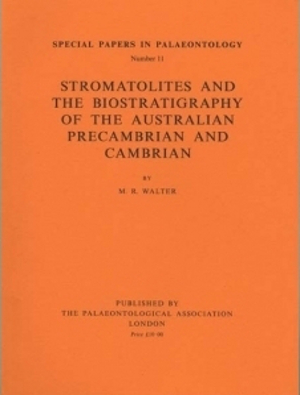Reg. Charity No. 1168330

The modem Russian methods of stromatolite classification and zonation of the Precambrian are tested in Australia on stromatolites from the Amadeus, Hamersley, Bangemall, McArthur, and Georgina Basins and the Antrim Plateau Volcanics, and from the Ventersdorp 'System' of South Africa, and are found to be generally applicable. Only columnar stromatolites are used and they are classified using their column shape, orientation and branching, lamina shape and, infrequently, microstructure. Taxa intergrade, but each has a distinct mode in its range of variation and the taxa boundaries are defined between these modes.
There is a positive correlation between lamina shapes and the gross shapes of stromatolites. Studies of modem stromatolites and algae have revealed that lamina shape depends on the shape of the algal plant forming the stromatolite and that plant shape depends on the algal taxa involved as well as on the environment of growth. Hence the shape of stromatolites depends at least to some extent on the algae which build them.
Reconstructions of the appearance during growth of the Amadeus Basin stromatolites shows a resemblance to modem stromatolites in Shark Bay, Western Australia (but there are numerous differences in detailed morphology). The stromatolites in the Bitter Springs Formation of the Amadeus Basin form widespread biostromes which probably are diachronous, like those presently forming around the Persian Gulf. A petrological study indicates that although many of these stromatolites are now dolomite, they were probably originally aragonite and a morphological study indicates that they grew subtidally.
New correlations which are more precise than previously possible are made between the Amadeus Basin and Adelaide Geosyncline. The upper Bitter Springs Formation of the Amadeus Basin is intermediate in age between the Umberatana Group and the Skillogalee Dolomite of the Burra Group, Adelaide Geosyncline. Both the upper Bitter Springs Formation and the Umberatana Group contain rich stromatolite assemblages indicating correlation with the Upper Riphean (950±50-680±20 m.y.). The Skillogalee Dolomite contains a Middle Riphean (1350±50-950±50 m.y.) assemblage. Middle Riphean stromatolites also occur in the McArthur Basin and in the Bangemall Group of the Bangemall Basin. A Cambrian stromatolite from the Amadeus Basin is distinct from all Precambrian stromatolites, except some from the very latest Precambrian, but is similar to other Cambrian stromatolites in possessing a very distinctive vermiform microstructure which first appears in stromatolites just prior to the beginning of the Cambrian. A probably Early Cambrian stromatolite from the Georgina Basin is a new kind closely related to Jacutophyton. Two forms of Conophyton are identified from the latest Precambrian or Early Cambrian Antrim Plateau Volcanics. The correlations suggested are all consistent with known stratigraphic, palaeontological and radiometric data, except some new radiometric data from the Adelaide Geosyncline which have yet to be confirmed. The zoning scheme is extended to the early Proterozoic and three distinctive stromatolites are identified from the Mount Bruce Supergroup (approximately 2000 m.y. old). These are different from younger stromatolites but one also occurs in the early Proterozoic Ventersdorp 'System' of South Africa. However, a fourth stromatolite from the Mount Bruce Supergroup is indistinguishable from a Riphean form.
The taxa described are Conophyton basalticum, C. garganicum australe, C. g. ?garganicum, C. cf. gaubitza, Georginia howchini, Acaciella aurtralica, Alcheringa narrina, Baicalia capricornia, Basisphaera irregularis, Boxonia pertaknurra, Inzeria intia, Jurusania nisvensis, Kulparia alicia, Linella avis, Madiganites mawsoni, Minjaria pontifera, Patomia f. indet ., Pilbaria perplexa, Tungussia erecta, and T. inna.